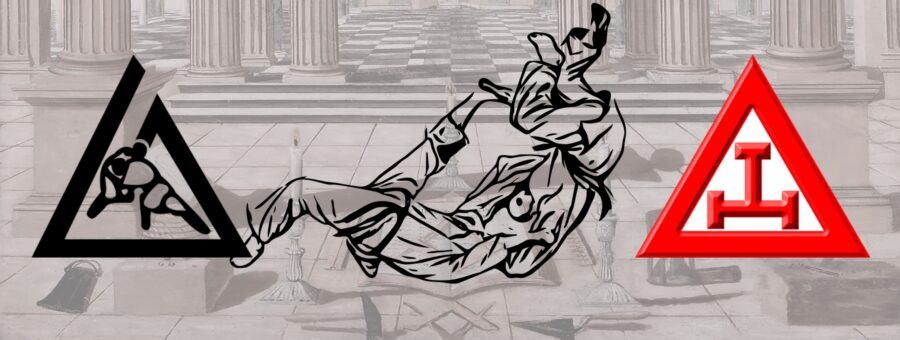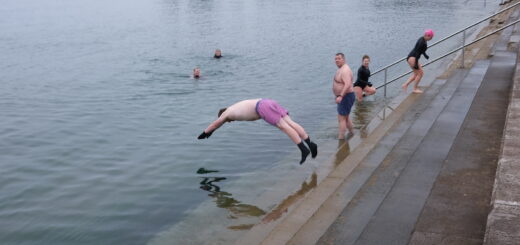Why I Started BJJ and How It Relates to Freemasonry

Shôn Ellerton, Feb 6, 2024
Having recently started BJJ, I have found many parallels with Freemasonry in terms of friendship, respect, and most importantly of all. Having a bit of fun.
In my, already, busy life, what on earth possessed me to start Brazilian Ju-Jitsu, or BJJ for short, in my mid-fifties? Surely, this is asking for trouble, is it not? Creaking limbs. Aching joints. Bad flexibility. You name it. Once you get up there in the mid-fifties, all this sort of stuff creeps up on you.
Fair enough, I have been taking care of myself during the last several years on account of realising that I have neglected my physical health from my late thirties due to being, somewhat, of a workaholic. The work hard, play hard mentality is one thing, but if this means not getting any physical exercise and mental relaxation, it’s likely, something’s going to give. In my case, I snapped mentally and after taking a bit of break from it all, I decided to make some health changes.
Let me tell you, allowing one’s career to take priority over one’s own health is a very bad idea.
During the last several years, I’ve ate far more healthily, regularly go to the gym, jog a couple of times a week, go for hikes, joined the Freemasons, done charity work with the Lions, joined a couple of school boards, and, of course, have taken part in many of my son’s activities, including his sports and Scouts group. Honestly, most of my weekday evenings are booked out with any of the above activities. No doubt, they have made a vast difference to my physical and mental wellbeing. Freemasonry, without a doubt, has been one of the most profound and fulfilling experience in the few years that I’ve been a member. There’s just so much to learn.
But there was something missing. Not doing any sports or other physical activities involving contact with others. In my late twenties and early thirties, I was heavy into squash and rock climbing, and even played a wee bit of rugby, but since then, apart from the occasional five-a-side football match, done very little. Many physical activities I enjoy are primarily solo-based or one-on-one with a friend. And I was never much into team sports because I found most, if not all of them, rather dull and repetitive. It’s all about the winning and trying to get the gold. Yeah, fine, if you’re into statistics and points counting. For me, the only three events I will watch during the Olympics are gymnastics, ice skating and judo. The rest of it is all repetitive and pretty much the same. And I really couldn’t care less who wins either.
I was often toying with the idea of doing something else, but as many of us are aware, thinking about something is rather different than actually doing it. I wanted something physical and complex but involving a strong knit group of people as well.
Funny enough, what led up to that moment in committing myself to start BJJ was my son’s recent but short-lived moment with karate. He joined an outfit called GKR Martial Arts. I don’t know much about karate at all except for what I have observed watching martial arts films, many of which, seem to be highly orchestrated for entertainment value. In any case, despite my son’s pleading that I should join as well, it just wasn’t my thing. The karate class my son took concentrated on drilling movements rather than sparring one-on-one. There was little or no contact. Belts seem to be given readily based on the number of times you attend the gym rather than earning them through what you know and how well you know it. It was an odd place in many respects. You check your child in through a digital scan while most of the parents sit disinterested on the sidelines glued to their mobile phones.
Although maybe a little petty, another annoyance with the gym, and I am sure, many others as well, is the military-like subservient way that instructors expect to be treated by their students. Any utterance given by the instructor must be repeated with a loud ‘hi!’ to show your absolute obedience to the ‘sensei god’. The skill levels by the instructors varied enormously and perhaps, a part of this, is that GKR promotes a path of progression to being a black belt within a relatively short four-year period according to its website and pamphlet. Many in the karate community do not hold GKR in particularly high regard due to many of these concerns. But this criticism could be a little harsh considering that many taking the class were young children and, quite understandably, I think many parents would get concerned if their kids were doing full contact karate. Getting whacked in the face with the possibility of getting a chipped tooth and most assuredly, a black eye, isn’t something I’d like my son to experience starting his martial arts journey and considering the resilience and flexibility of young kids, lower back and neck injuries from throws and chokeholds in judo and BJJ are far less likely to happen. For kids, at least a parent was assured that one’s child is safe in a GKR Karate gym, and perhaps, maybe taking that harder line of ‘yes Sensei!’ respect isn’t such a bad thing for younger people. Also, for kids, getting more frequent belt gradings keeps them more motivated and interested. But for adults? Not sure.
Being tempted to return to martial arts in the form of judo when I was at high school, I did join the occasional club during my frequent moves around the world from time to time, but never really clicked into a routine or a regular gym. It was very similar to my concert piano days during the same period in high school. I went out of practice but had a renewed interest about ten years ago and started to play it again on a very casual basis. I’m not nearly as good as I used to be, and that’s fine.
My son was already losing interest in his karate but became quite enthused when I was actively seeking a nearby judo club. Failing to find one that appealed to me with a time schedule suitable for me, I looked for alternative martial arts. There were a few Jiu Jitsu, MMA (mixed martial arts), Muay Thai boxing, and BJJ gyms nearby. Not knowing much about them, I came across a smallish one practicing BJJ, MMA and kickboxing. I took my son there for a children’s class and he loved it. He was a little freaked out at first, being in such close contact with another kid, but he learned to overcome this quite easily. Perhaps this is something which many kids miss out on. The ability to be very close physically to others without the stigma of being accused of encroaching on someone else’s personal territory.
For those of us adults getting older who want to rekindle a martial art, or some sort of sport which involves sparring, it’s a bit daunting when most of the others there in the dojo are late teenagers and young men in their twenties and early thirties. Especially something like judo or BJJ in which very close contact is inevitable. I once sparred with this nineteen-year old who was literally all over the show with little or no control over his strength, which was far superior to mine. The only way for an older man to dominate a younger and stronger man is mastering technique rather than brute strength. In Mandarin, Jiu Jitsu is known as róushù, or literally, soft skills or technique. With none of these skills, I was locked in a choke hold in no time flat. Thankfully, I tapped out quickly, but I had one heck of a sore neck for a few days after. Two injuries to really avoid in judo and BJJ are lower back and neck injuries and the best way to avoid this is to lose the ego, be a wimp, and tap out when you know you’re in trouble.
I tried out a couple of evening classes led by a mid-forties, tough, wiry-looking chap festooned with tattoos. He’s actually a very nice and friendly chap despite his physical description. Naturally, my first fear in turning up to the gym would be that the only others there would either be young men or teenagers. But that wasn’t the case at all. There was an accountant, an electrical engineer, a restauranteur, a school teacher, and a metal and tooling works business owner, ranging from their mid-thirties up to fifty. It was gratifying to know that everyone has the grace to respect the physical limits of an older person, particularly so, when one starts out in the art. In a way, it’s kind of a nice moment to reflect on this. As a youth, the instructors would push and push you, but when you’re over the hill, the instructors tell you to sit out and take a break whenever you like.
BJJ sessions are of two forms. One with a gi, a heavy-duty version of the kimono used by most martial arts, and no gi, which, as the name describes, is when you simply spar or roll with your opponent in normal gym clothing, or preferably, close-fit rashies or compression gym wear. One’s neither more difficult than the other. Just different. Not being familiar with no gi, the art of grappling slippery bodies relying on more pronounced hip holds and other locking techniques was novel and challenging. I had remembered some of my takedown methods with gi, but I was an absolute novice on the ground.
BJJ and Judo are absolutely exhausting. Even my son, usually a bottomless pit of energy, tired out quickly after doing a couple of rolls. I would expect the same with wrestling, but nearly every muscle is being stressed out. I’m hoping that the fallout will reduce in time, but the next day, I am aching all over. My neck is a little sore having first-hand experienced of several chokeholds. My finger joints on the left hand are sore from constant grappling the other guy’s gi in the so-called death grip. I’ve got several bruises along my chest from elbows pinning me to the ground. I recover by rubbing ointment later and I learn to keep moving which lessens the soreness and the stiffness, but I can’t help thinking that if one’s not careful or gets over enthusiastic doing a roll, an injury is going to happen. In reality, I am informed that BJJ is, in general, safer for older people than others like karate, taekwondo, and even, judo. The first thing I remembered when I started judo as a kid was to learn how to fall. I still have that instinct.
I wish I kept it up from the time I stopped up to now, but re-starting something that you want to do is better than not starting at all. Having remembered some groundwork in judo, it didn’t freak me out being in such close proximity to another opponent. If anything, it really bonds people together. Literally. Giving or receiving a chokehold is about as close as you’re going to get. You easily make new friends and start up topics of conversation one wouldn’t normally make with others.
This leads me to the most arresting point of BJJ. The way that it brings people together. In this small dojo, I was pleasantly surprised that many of the students have been there for many years and have got to know each other like good friends. Unlike some gyms, there is an air of casualness about it. The instructor, a seasoned black belt under Robert Drysdale himself, doesn’t go for all the ‘yes, sensei!’ crap. Sure enough, there is an implied respect to those senior in the ranks in terms of grading, but I liken to how the gym operates not entirely dissimilar to how the Freemasons conduct their lodge meets. Nobody calls anyone ‘sir’ but by first names and even ‘brother’, implying that all are equal in terms of respect but, like Freemasonry, there is deep and implied respect to those who have acquired more knowledge in the craft.
By the way, BJJ is notoriously difficult in belt grading. It can take two to three years to obtain a blue belt, another two to three years to obtain a purple, leaving the brown and the black belts to the very few who persevere over fifteen to twenty years. A purple belt is considered to be the beginning of entering the advanced grades. Kids under the age of sixteen are the exception in which other various coloured belts are given out on a more frequent basis; however, in BJJ, no one under the age of sixteen is permitted to receive the blue belt which is the next ‘real’ belt in BJJ.
But is it really important to focus on belts? Not at all.
Unlike some institutions who boast they can get you up to black belt status in a matter of three to four years, a good BJJ outfit will encourage you to enjoy the journey and have some fun on the way. This is, interestingly enough, a very similar approach in Freemasonry. In Freemasonry, to go from Entered Apprentice to Past Master, a journey which can take a minimum of seven years going up to many more dependent on one’s commitment, it is the journey itself which should be savoured and enjoyed. Those who rush into being black belts given by less-esteemed institutions or those who rush to becoming a master of a lodge by ‘skipping chairs’, not only tend to miss out so much on the way, but become either not very happy in their accelerated roles or just not very good at it. Martial arts black belts and past masters in Freemasonry must develop a vast amount of knowledge within their respective crafts and be deeply committed. In the world of Freemasonry, I accelerated and committed myself to the best of my abilities and with less than three years to go before going into the Master’s chair, I feel that I have still so much to learn. Whether I display that same commitment to BJJ is uncertain as of yet, however, I can say that it is a fun thing to do. And that may be enough for me.
I often asked the question to others as to why they joined.
One of the teenagers joined because he was getting bullied about. BJJ and wrestling are probably the best ways to learn how to overcome someone in a fight, because, in most cases, fights very quickly end up on the ground. I’m sure many of us have seen two kids fighting. They’re not standing apart with fists curled up boxing the heck out of each other James Dean style. What they’re doing is grappling each other clumsily and they end up rolling around on the ground. Those who’ve practiced wrestling and BJJ have that advantage of pinning someone else into submission.
Another case. An older guy in his forties said to me that doing BJJ is the ultimate fitness workout, which I completely understand having gone through it. Despite my regular gym and jogging sessions, I am not getting near the same level of workout as I am with BJJ. Literally, at the end of an hour and a half’s session, I felt that I sweated an entire swimming pool. And let’s face it. Going to the gym is basically as boring as bat’s turds. With BJJ and other similar activities, it should be fun as well as being instructional and not just being a hard workout. It’s also the perfect environment to really make good friends as well. I’ve been to a number of gyms for quite extensive periods of time and really don’t feel the want to socialise much. Most everyone is listening to their headphones immersed in their own little worlds or admiring themselves narcissistically in front of the mirrors. Apart from gym classes, most who attend a gym, go in and do their allotted workout, and quickly leave.
One of the most compelling reasons for many joining BJJ, or that matter, any other activity involving being with others in the flesh, is to reconnect in society. Much has been publicised on the topic of loneliness, particularly among men, in society. Divorcees, widows, ex-military, and others struggling to cope with modern society find friendship and a sense of belonging by joining a club with real people. It is of no surprise that a significant percentage of those who are in Freemasonry come from the services for this reason. Some, who I encountered, at the gym ‘found themselves’ in this way because they felt lost when they were thrust back into civilian society, especially those who may have lost a spouse.
I discovered many similarities with Freemasonry and BJJ. Physical workouts aside, they both require an immense amount of practice to master. Mentally, they are both challenging. One requiring how to negotiate physical chess-like skills to outmanoeuvre your opponent, and the other, to conduct very complex ritual and be able to understand the meaning behind it. In any case, they both bring people together closely because you have shared an intense experience with them. This, of course, is not limited to BJJ and Freemasonry, but whatever the activity is, it seems that if it involves a higher degree of difficulty or complexity, it is more conducive to forging exceptionally strong relationships. Much of our loneliness and depression symptoms in today’s society will be lessened by joining groups of likeminded people doing difficult things.


